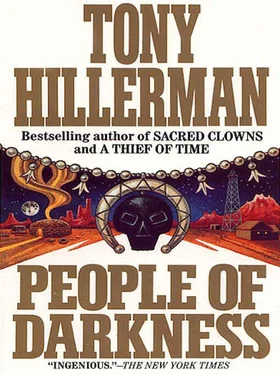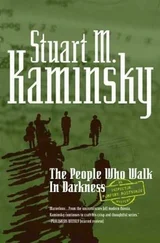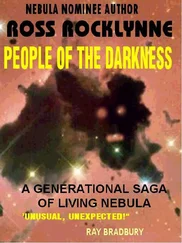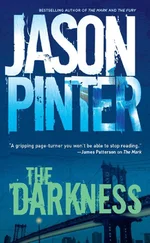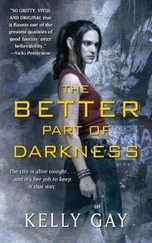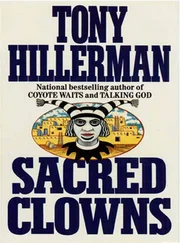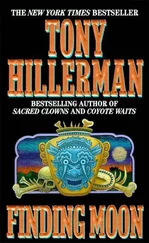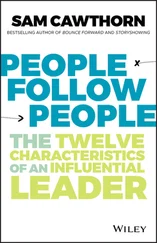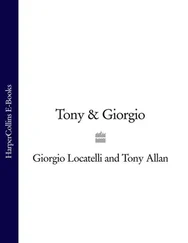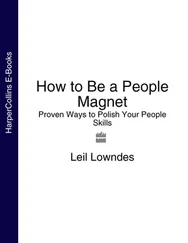“Better watch the weather,” the dispatcher said. “It’s snowing some over on the west side. Inch on the ground at Ganado. Not supposed to amount to much, but you know how that is.”
“We’ll watch it,” Chee said. He flicked the radio switch and put the pickup back into gear.
“What are you thinking?” Mary asked.
Chee frowned at the windshield. “Mostly, I’m just taking a shot in the dark.”
“But just mostly,” Mary said. “Have you figured a way that Vines and the oil well connect?”
“They must,” Chee said. “They have to connect. If not Vines, then Gordo Sena. One or the other has to connect.”
Mary laughed. “Sure,” she said. “Now all you have to do is figure out how.”
“I think I have,” Chee said. “At least part of it.”
The track angled to the right and up the slope of dark-blue shale marbled with reddish impurities. Above it, the top of the butte loomed, now no more than a thousand yards away. Chee shifted down. Mary was watching him impatiently.
“I’m waiting,” she said.
“Okay,” Chee said. “First we agree there has to be a reason. White man or Navajo, you do things for a reason. With a Navajo, something this bad – blowing up people wholesale – would have to be witch business. Irrational. Evil for the sake of evil. No other motive would make sense. For the white man, I think it would be greed.” He glanced at her. “All right so far?”
Mary looked puzzled. “I guess so,” she said.
“If we’re dealing with witchcraft, what’s happened since doesn’t connect. Maybe a Navajo would want to kill the Charleys if he knew they were witches who’d done him harm. That’s happened. But he would do it in the heat of rage, not years later. So let’s set that aside.”
Mary shrugged.
“So we’re dealing with a white man’s crime,” Chee continued. “The motive’s greed. Who gains by blowing up an oil well? You have to remember where that well was. We couldn’t find the remains because the Red Deuce has swallowed up the site. So the oil company drilling the well had a mineral rights lease on that piece of land. If the well produces oil, the lease is extended as long as production lasts. That’s the standard oil lease form. So let’s say somebody knows there’s a uranium deposit under the well. Who’d benefit?”
“You mean the Senas? Because it was on their ranch?”
“Maybe the Senas,” Chee said. “When it finally did happen, uranium made Gordo Sena rich. But something doesn’t fit with thinking Gordo did it.”
“You mean like killing his own brother?” Mary asked. “Maybe Robert Sena planned it himself and then something went wrong and he killed himself, too.”
“I didn’t mean that,” Chee said. “I meant the Sena ranch is like most ranches out here. It’s a little bit of privately owned land connected to a big spread of federal Bureau of Land Management land. Most of what you own is a permit to graze your cattle on BLM land. That’s where the well was drilling. On federal land. The Senas had the grazing lease, but it was about a quarter of a mile from the boundary of their own land. So they wouldn’t benefit directly from either an oil strike or a uranium find. Sena got rich because the uranium deposit spread over onto his family property.”
“So you rule out Sena,” Mary said. “Who then?”
“I don’t quite rule out the Senas,” Chee said. “There’s a piece missing somewhere. I can’t think it through.”
The pickup tilted abruptly downward into a narrow wash. Chee shifted into his lowest gear, braked to a stop, and inspected the arroyo. The problem would be pulling the truck up the other side. The arroyo carried very little water even after down-pours, and a tall growth of mesquite and rabbit brush on both sides of the track had limited erosion. But still, years of cutting away had made the opposite bank steep enough so that getting traction to the pickup out of it looked chancy.
“Looks like the end of the line,” Mary said. “But aren’t we close enough to walk?”
“We’ll try the pickup,” Chee said. “If we don’t make it, there’s plenty of room down there to turn it around.”
The vehicle produced a great shower of flying gravel, lost traction briefly, and skidded sideways. But it made the brief, steep climb. Ahead now, no more than four hundred yards away, they could see three gnarled cottonwoods. In a desert climate they signaled either a spring or a very shallow water sand that could be tapped by a well. And that in turn explained why this track led across the badlands and why the Tsossies had picked the site for their hogan. Chee and Mary could see the hogan now about twenty feet beyond the trees. It was a hexagon of stacked sandstone slabs, roofed with poles which radiated outward from a central smoke hole. The earth that once insulated the roof against cold and heat had long since washed away.
Chee pulled the pickup to a stop against an outcrop of cliff. He clipped on his holster and hung his binocular case around his neck. “Be prepared,” he said, and stepped out into the wind.
The doorway of the hogan was closed with planks nailed across the lintel logs. The only opening now was on the north side – a hole knocked through the stone wall to provide an exit for the ghost and to warn strangers that this was a death hogan. Chee stood looking into the hole. The evening light that filtered through the latticework of roof showed nothing but odds and ends of junk too worthless to carry away even by an impoverished family. Dirt had blown in and tumbleweeds had bounced through the ghost hole, but the danger posed by the chindi had made the place secure from scavengers.
“If Tsossie didn’t die here, someone did,” Chee said. “Let’s find the place the old lady said they put him.”
Mary was staring at the hogan. “I’ve heard about this,” she said, “about Navajos not using buildings after somebody dies in them. It seems awfully wasteful.”
“Unless maybe they died of something contagious,” Chee said. “When the custom started, I guess that was the purpose.”
“They carry the body out the hole? Is that right? Always on the north side?”
Chee didn’t want to talk about it now. The wind gusted again, carrying around a light load of dry, feathery snowflakes. “North is the direction of evil,” he said.
Mrs. Musket had told them the blowhole was in the mesa wall, west of the hogan. The butte was formed of layers of geological formations, capped with a gray erosion-resistant granite. Below that was a stratum of red sandstone perhaps thirty feet deep, which covered porous, whitish volcanic tuft that had been riddled with wind pockets and seepage holes. Only two of these near the hogan were large enough for a burial. Chee examined both through the binoculars and saw nothing conclusive. They climbed the talus slope toward the nearest one. Against the perpendicular walls of the butte, sections of the soft perlite had been worn away, undermining the sandstone. A section of it had fallen in a clutter of blocks, each as large as a freight car. Chee scrambled up the sloping side of one of the blocks and looked into the blowhole. Rocks had been piled on its floor. From beneath one of them a ragged fragment of blue cloth protruded. The wind eddied into the hole. The cloth fluttered.
“Come on up,” Chee said. “I guess we found Windy Tsossie.”
Sometimes the dry cold of a desert winter will protect a corpse from decay and turn it into a desiccated mummy. Since the placement in the cliff and the covering of rocks had protected Tsossie from both animal predators and scavenger birds, this might have happened to him. But Tsossie, apparently, had died in the summer, and thirty years of insects had reduced what he had been to a clean white skeleton.
Читать дальше
